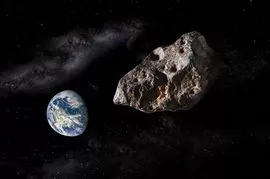Despite earlier dismissals of a potential collision, a new study suggests a dramatic twist in the trajectory of the giant ‘God of Chaos’ asteroid. Experts have recently revised their stance on the data concerning the path of 99942 Apophis, a colossal asteroid.
Contrary to earlier claims that the asteroid was not on a collision course with Earth, a study led by Canadian astronomer Paul Wiegert reveals that its trajectory could unexpectedly alter if impacted by even a small object. This renewed concern over the ‘God of Chaos’ threat also aligns with previous forecasts that anticipated the asteroid passing extremely close to Earth—within 18,300 miles—on Friday the 13th, April 13, 2029
What are the odds of the giant asteroid impacting Earth?
Discovered in 2004, the asteroid 99942 Apophis was initially believed to have a 2.7% chance of impacting Earth in 2029. Although later observations ruled out a collision in both 2029 and as late as 2036, new findings from Paul Wiegert have issued a more ominous warning. According to a report from the *Daily Star*, Wiegert explained: “The odds of an unseen small asteroid deflecting Apophis enough to cause a collision with Earth in 2029 (with a minimum size of 3.4 meters and a velocity change greater than 5 × 10^(-2) m/s) are approximately 1 in 100 million.”
However, Wiegert also emphasizes that the overall probability of the ‘God of Chaos’ asteroid striking Earth is still less than one in two billion. “Given that only 5% of such impacts would propel Apophis in a direction that could lead to a collision, the chance of such an event is extremely low,” he stated.
For those uncertain about the specifics, Google Gemini clarifies that for a course-changing impact, the distance “d” must be at least 3.4 meters, and the change in velocity “Δv” must exceed 5 × 10^(-2) meters per second.
Furthermore, Wiegert noted that Apophis has been “largely unmonitored by telescopes since May 2021 and will remain so until 2027.” This is due to the relative positioning of Apophis, Earth, and the Sun, which keeps the asteroid in the daytime sky, making observation difficult.
More about Apophis asteroid
NASA has described Apophis as a “near-Earth object (NEO) estimated to be about 1,100 feet (335 meters) in diameter.” Initially, it was identified as one of the most potentially hazardous asteroids with a chance of impacting Earth. However, a radar observation campaign conducted in March 2021 dismissed this threat, with astronomers concluding that there was no risk of collision for at least the next century.
Regarding the initially predicted potential impact in 2068, Davide Farnocchia of NASA’s Center for Near-Earth Object Studies stated in 2021: “A 2068 impact is no longer within the realm of possibility, and our calculations do not indicate any impact risk for at least the next 100 years.”
The asteroid’s name, Apophis, is derived from ancient Egyptian mythology, where it represents a demon serpent that personifies evil and chaos.
Revisiting the Odds
Despite earlier assurances, new calculations from Wiegert suggest that while the probability of Apophis colliding with Earth remains extremely low—less than one in two billion—the risk is not zero. The recent revelation highlights that if a smaller asteroid were to deflect Apophis, the chances of a collision could increase, sparking renewed calls for vigilance.
NASA has downplayed concerns, with Davide Farnocchia from the Center for Near-Earth Object Studies stating, “A 2068 impact is no longer within the realm of possibility, and our calculations do not show any impact risk for at least the next 100 years.” Yet, the asteroid’s unpredictable nature—echoing its namesake, the demon serpent Apophis from Egyptian mythology, a symbol of chaos and destruction—continues to capture the public imagination.
Conclusion
While the risk of an asteroid impact by Apophis remains remote, it serves as a stark reminder of the unpredictable threats lurking in our cosmic neighborhood. The renewed attention to the ‘God of Chaos’ offers both challenges and opportunities: a call to action for advancing technology, strengthening international collaboration, and preparing for the unthinkable while hoping it remains an event confined to fiction rather than reality.

